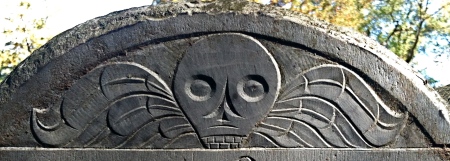Prior installments in this series (seen here, here, and here) examined the most famous Puritan grave symbol, the winged skull called a “death’s head.” Today’s post traces the evolution of the death’s head from a stern, menacing figure into softer imagery. Throughout the Puritan era, the winged skull remained the single most common gravestone decoration. Yet around 1690, an interesting change began. Fifty years later, the death’s head was transformed.
We begin with a typical death’s head, from the 1680s, which stares insistently. This design was used by many engravers around Boston, without much variation:
On the next stone (below), the death’s head wears finely curved eyebrows. This detail was popularized by Joseph Lamson (discussed here), and became common practice:
In the next stone, representative of many graves from the early 1700s, we again see the eyebrows and also note a mustache. This gives the sense of a face superimposed upon the skull:
Fifteen years later (below), the mustache resembles a small frown. The skull almost has two mouths, with massive teeth beneath and a small pout above. Again, we have the idea of a face and skull combined:
Next, the teeth move downward and become smaller (below). The face appears more pronounced:
As the teeth are made smaller (below), they come to resemble a neck, supporting the skull. Suddenly, there is more room for the frown, which now dominates the expression:
By the mid-1700s, this pouting skull had almost entirely replaced the original death’s head. It expresses a softer emotion—sad but not menacing—and projects a more human form. It persisted as the single most prevalent gravestone design throughout New England until around 1800. And in some instances (below), the frown became a tiny smile. The fearsome death’s head was completely transformed:
The reasons for this evolution are unclear. Puritan carvers began with a menacing death’s head, perched insistently upon the grave, and over fifty years, transitioned to a gently pouting (or even smiling) figure that looked slightly more like a face than a skull. The later graves expressed a different emotion, and it is tempting to think that this represented a changed approach to death.
Certainly Puritan society became more secure as it entered its second century in America. The colonists gained familiarity with the land and seasons, they built an economic order, and their settlements expanded. Perhaps this societal maturation extended to the grave, as the confidence of cultural continuity might temper the loss of family and friends. They may have felt less need for fear and more room for sorrow. The gentler face of death may have been a reflection of this change.
Tune in for the next essay, which will examine a curiosity of the Puritan calendar, captured forever in their slate gravestones. If you enjoy these posts, please consider subscribing; just scroll to the bottom and click ‘Follow this Blog.’
(All photographs taken by the author.)













Pingback: New England Graves: Flight of the Soul. | An Armchair Academic
great articles my favorite graveyard is in marblehead ma